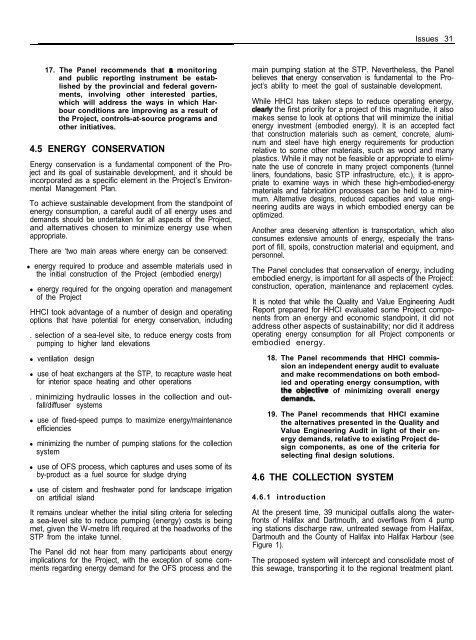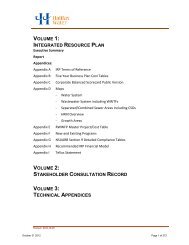Halifax Harbour Cleanup Inc. - Halifax Regional Municipality
Halifax Harbour Cleanup Inc. - Halifax Regional Municipality
Halifax Harbour Cleanup Inc. - Halifax Regional Municipality
Create successful ePaper yourself
Turn your PDF publications into a flip-book with our unique Google optimized e-Paper software.
Issues 31<br />
17. The Panel recommends that a monitoring<br />
and public reportlng instrument be established<br />
by the provincial and federal governments,<br />
involving other interested parties,<br />
which will address the ways in which <strong>Harbour</strong><br />
conditions are improving as a result of<br />
the Project, controls-at-source programs and<br />
other initiatives.<br />
4.5 ENERGY CONSERVATION<br />
Energy conservation is a fundamental component of the Project<br />
and its goal of sustainable development, and it should be<br />
incorporated as a specific element in the Project’s Environmental<br />
Management Plan.<br />
To achieve sustainable development from the standpoint of<br />
energy consumption, a careful audit of all energy uses and<br />
demands should be undertaken for all aspects of the Project,<br />
and alternatives chosen to minimize energy use when<br />
appropriate.<br />
There are ‘two main areas where energy can be conserved:<br />
• energy required to produce and assemble materials used in<br />
the initial construction of the Project (embodied energy)<br />
• energy required for the ongoing operation and management<br />
of the Project<br />
HHCI took advantage of a number of design and operating<br />
options that have potential for energy conservation, including<br />
. selection of a sea-level site, to reduce energy costs from<br />
pumping to higher land elevations<br />
• ventilation design<br />
• use of heat exchangers at the STP, to recapture waste heat<br />
for interior space heating and other operations<br />
. minimizing hydraulic losses in the collection and outfall/diffuser<br />
systems<br />
• use of fixed-speed pumps to maximize energy/maintenance<br />
efficiencies<br />
• minimizing the number of pumping stations for the collection<br />
system<br />
• use of OFS process, which captures and uses some of its<br />
by-product as a fuel source for sludge drying<br />
• use of cistern and freshwater pond for landscape irrigation<br />
on artificial island<br />
It remains unclear whether the initial siting criteria for selecting<br />
a sea-level site to reduce pumping (energy) costs is being<br />
met, given the W-metre lift required at the headworks of the<br />
STP from the intake tunnel.<br />
The Panel did not hear from many participants about energy<br />
implications for the Project, with the exception of some comments<br />
regarding energy demand for the OFS process and the<br />
main pumping station at the STP. Nevertheless, the Panel<br />
believes that energy conservation is fundamental to the Project’s<br />
ability to meet the goal of sustainable development.<br />
While HHCI has taken steps to reduce operating energy,<br />
cleariy the first priority for a project of this magnitude, it also<br />
makes sense to look at options that will minimize the initial<br />
energy investment (embodied energy). It is an accepted fact<br />
that construction materials such as cement, concrete, aluminum<br />
and steel have high energy requirements for production<br />
relative to some other materials, such as wood and many<br />
plastics. While it may not be feasible or appropriate to eliminate<br />
the use of concrete in many project components (tunnel<br />
liners, foundations, basic STP infrastructure, etc.), it is appropriate<br />
to examine ways in which these high-embodied-energy<br />
materials and fabrication processes can be held to a minimum.<br />
Alternative designs, reduced capacities and value engineering<br />
audits are ways in which embodied energy can be<br />
optimized.<br />
Another area deserving attention is transportation, which also<br />
consumes extensive amounts of energy, especially the transport<br />
of fill, spoils, construction material and equipment, and<br />
personnel.<br />
The Panel concludes that conservation of energy, including<br />
embodied energy, is important for all aspects of the Project:<br />
construction, operation, maintenance and replacement cycles.<br />
It is noted that while the Quality and Value Engineering Audit<br />
Report prepared for HHCI evaluated some Project components<br />
from an energy and economic standpoint, it did not<br />
address other aspects of sustainability; nor did it address<br />
operating energy consumption for all Project components or<br />
embodied energy.<br />
18. The Panel recommends that HHCI commission<br />
an independent energy audit to evaluate<br />
and make recommendations on both embodied<br />
and operating energy consumption, with<br />
tiimo;2+tive of minimizing overall energy<br />
.<br />
19. The Panel recommends that HHCI examine<br />
the alternatives presented in the Quality and<br />
Value Engineering Audit in light of their energy<br />
demands, relative to existing Project design<br />
components, as one of the criteria for<br />
selecting final design solutions.<br />
4.6 THE COLLECTION SYSTEM<br />
4.6.1 introduction<br />
At the present time, 39 municipal outfalls along the waterfronts<br />
of <strong>Halifax</strong> and Dartmouth, and overflows from 4 pump<br />
ing stations discharge raw, untreated sewage from <strong>Halifax</strong>,<br />
Dartmouth and the County of <strong>Halifax</strong> into <strong>Halifax</strong> <strong>Harbour</strong> (see<br />
Figure 1).<br />
The proposed system will intercept and consolidate most of<br />
this sewage, transporting it to the regional treatment plant.

















